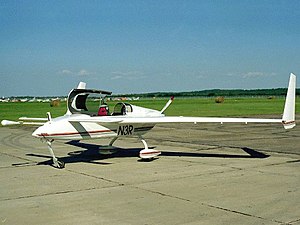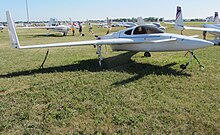Rutan Long-EZ
| Long-EZ | |
|---|---|
 | |
| General information | |
| Type | Homebuilt aircraft |
| National origin | United States of America |
| Manufacturer | Rutan Aircraft Factory TERF Inc, (plans suppliers) |
| Designer | |
| History | |
| First flight | June 12, 1979[2] |

The Rutan Model 61 Long-EZ is a tandem 2-seater homebuilt aircraft designed by Burt Rutan's Rutan Aircraft Factory. The Long-EZ has a canard layout, a swept wing with wingtip rudders, and a pusher engine and propeller. The tricycle landing gear has fixed main wheels with streamlined spats and a retractable nosewheel. Its predecessor was the VariEze, plans for which were first available to homebuilders in 1976. The prototype Long-EZ, N79RA,[3] first flew on June 12, 1979.
Design
[edit]
The Long-EZ was a scaled-up redesign of the VariEze predecessor, allowing for the use of readily available Lycoming aircraft engines instead of the Volkswagen-derived engines or hard-to-find small Continentals for which the VariEze was designed. Changes from the VariEze included a larger main wing with modified Eppler 1230 airfoil and less sweep, larger strakes containing more fuel and baggage storage, and a slightly wider cabin. The canard uses the same GU25-5(11)8 airfoil as the VariEze. Plans were offered from 1980 to 1985. There were about 700 FAA-registered Long-EZs in the United States in 2005, which had grown to 833 in 2021.
In January 1985 it was announced that plans for a new canard were being offered, to eliminate "rain trim change" that had been experienced by Long-EZ pilots.[4] This trim change is usually a nose-down trim change experienced when flying into rain requiring a small aft force on the stick to maintain altitude, which is easily trimmed out, using the bungee trim system. The new canard was designed with the Roncz R1145MS airfoil, which produces considerably more lift than the original GU25-5(11)8 airfoil. This enabled the new canard to be designed with less span, reducing wetted area and thus drag. The new canard has a negligible rain trim, and rain adds only 2 knots to the stall speed.
The aircraft is designed for fuel-efficient long-range flight, with a range of just over 2,000 miles (3,200 km).[5] It can fly for over ten hours and up to 1,600 miles (2,600 km) on 52 gallons (200 liters) of fuel.[6] Equipped with a rear-seat fuel tank, a Long-EZ flew for 4,800 miles (7,700 kilometers) in December 1979, still the record for aircraft weighing less than 1000 kg.[7]
The pilot sits in a semi-reclined seat and controls the Long-EZ with a side-stick controller on the right-hand console. It has an airbrake on the underside, and the wing-tip rudders can be deflected outwards to act as auxiliary airbrakes.[6]
In 1996 Burt Rutan awarded TERF Inc. the job of publishing the plans for the Long-EZ and other of his aircraft under The Rutan Aircraft Factory CD ROM Encyclopedia to further assist new builders and maintenance for existing builders.[8][9] Some components for the design are supplied by Aircraft Spruce & Specialty.[10]


In 1997 Dick Rutan and Mike Melvill flew in convoy around the world in two Rutan Long-EZ aircraft that they had built. This "around the world in 80 nights" flight was called The Spirit of EAA Friendship World Tour, and some legs of it lasted for over 14 hours.[11]
Variants
[edit]- E-Racer
- An extensively modified redesign using Long-EZ wings with a fuselage modified for side-by-side seating, retractable landing gear, and larger automotive engine conversion powerplants.[12]
- EZ-rocket
- XCOR Aerospace modified a Long-EZ and replaced the engine with twin liquid-fueled rocket engines to form a flight test vehicle called the EZ-rocket, which was used as a proof-of-concept demonstrator. Initially, a follow-on version called the "Mark-1 X-Racer, was going to be developed for the Rocket Racing League,[13] but the Velocity SE was subsequently selected as the airframe for the Rocket Racer, rather than the Long-EZ.[14][15]
- Twin EZ
- Ivan Shaw built a Long-EZ and then converted it into a "Twin-EZ", an aircraft with twin wing-mounted Norton NR642 Wankel engines (precursors to the MidWest AE series).[16] Shaw, a Yorkshireman, later designed the Europa XS kitplane.
- Long ESA
- A 258 hp electric engine conversion. On 19 July 2012, pilot Chip Yates achieved 202.6 mph in level flight, making the aircraft the fastest man carrying electric powered aircraft.[17][18]
- Berkez or Berk-EZ
- Heavily modified Long-EZ with Berkut 360 components.[19]
- Wright Stagger-EZ

- A Steve Wright three-seater design, using standard Long-EZ wings but with a dihedral canard and a rounder, more capacious fuselage. The pilot seat is standard Long-EZ, the co-pilot seat is offset to the right and 13" rearward, and behind the pilot seat is a third seat for a passenger. The co-pilot has a control stick but no rudder pedals. Only one Stagger-EZ was built.[20]
- Long-distance EZ (G-WILY)
- A standard Long-EZ modified by Bill Allen for long distance, with two wing droptanks for extra luggage and a large additional fuel tank in place of a passenger seat. Bill Allen also installed a Wilksch WAM diesel engine in one Long-EZ that he had built.[21]
- Borealis

- Powered by a pulse detonation engine. The project was developed by the Air Force Research Laboratory and Innovative Scientific Solutions, Inc.[citation needed]
Specifications
[edit]Data from Jane's All The World's Aircraft 1982–83[2]
General characteristics
- Crew: 1 pilot
- Capacity: 1 passenger
- Length: 16 ft 10 in (5.12 m)
- Wingspan: 26 ft 1 in (7.96 m)
- Height: 7 ft 10 in (2.40 m)
- Wing area: 81.99 sq ft (7.617 m2)
- Empty weight: 710 lb (322 kg)
- Max takeoff weight: 1,325 lb (601 kg)
- Fuel capacity: 52 US Gal (197 L)
- Powerplant: 1 × Lycoming O-235 air-cooled flat-four engine, 115 hp (86 kW)
Performance
- Maximum speed: 185 mph (298 km/h, 161 kn) (max cruise)
- Cruise speed: 144 mph (232 km/h, 125 kn) (40% power)
- Range: 2,010 mi (3,230 km, 1,750 nmi)
- Service ceiling: 27,000 ft (8,200 m)
- Rate of climb: 1,750 ft/min (8.9 m/s)
Accidents and incidents
[edit]As of February 2023, 114 Long-Ez aircraft have been lost in accidents, with 44 fatalities. [22]
- On February 28, 1990, Wallace Reid Jr. died after his Long-EZ crashed into the sea off Santa Monica after entering heavy fog.[23]
- Singer-songwriter and actor John Denver died when his Long-EZ crashed on October 12, 1997, just off the coast at Pacific Grove, California. The NTSB believes that he inadvertently pushed on his right rudder pedal while twisting to the left in his seat as he struggled to operate the fuel selector valve, which on his aircraft had been moved by a previous owner to a position where it could more easily be reached from the passenger seat.[24] Contributing factors in the Denver crash were other pilot errors, a design that led to an overly optimistic pre-flight fuel-check estimate,[25] a known defective fuel valve that was very hard to turn, and non-standard placement of the fuel selector valve by the plane's builder, at variance with Burt Rutan's specifications. Denver was aware of the relocated valve prior to take off and had previously flown the aircraft only for approximately thirty minutes in an orientation flight the day before the accident, although he was an experienced pilot. The NTSB cited Denver's unfamiliarity with the aircraft and his failure to have the aircraft refueled as causal factors in the accident.[24] The aerodynamics of this unusual aircraft did not play a role in Denver's crash.
- On December 20, 1997, the author James Gleick crash-landed his Long-EZ at Greenwood Lake Airport in West Milford, New Jersey.[26] The pilot was on final approach when the engine lost power and landed short of the runway against rising terrain. Probable causes of this accident were deemed to be terrain conditions and the failure of the pilot to use carburetor heat, which resulted in carburetor ice. The pilot was seriously injured and the passenger, his young son, was killed.[27]
See also
[edit]Related development
Aircraft of comparable role, configuration, and era
References
[edit]- ^ Crescenti, Gennaro. "IN MEMORY OF DR. TIMOTHY L. CRAWFORD, NOAA AIR RESOURCES LABORATORY FIELD RESEARCH DIVISION, IDAHO FALLS, IDAHO" (PDF). Woods Hole Oceanographic Institution. Retrieved January 2, 2017.
- ^ a b Taylor 1982, p. 565.
- ^ "FAA REGISTRY N-Number Inquiry Results". Archived from the original on November 1, 2014. Retrieved January 3, 2010.
- ^ "Long-EZ Canard Update", The Canard Pusher Vol. 43, January 1985.
- ^ W.J. Hennigan (April 1, 2011). "Aerospace legend Burt Rutan ready for a landing". Los Angeles Times. Retrieved April 2, 2011.
- ^ a b Rutan Long-EZ Owners Manual, Second Edition - October 1983
- ^ "LONG-EZ BREAKS WORLD DISTANCE RECORD". The Canard Pusher (23). January 1980. Archived from the original on April 5, 2016. Retrieved May 16, 2016.
- ^ "Rutan Aircraft Factory Encyclopedia: Volumes 1, 2 & 3", Terf Inc., 1996.
- ^ TERF Inc. (2005). "Rutan Aircraft Factory CD ROM Encyclopedia". terf.com. Archived from the original on May 5, 2021. Retrieved October 14, 2021.
- ^ Aircraft Spruce & Specialty (2021). "Long EZ". aircraftspruce.com. Archived from the original on March 8, 2021. Retrieved October 14, 2021.
- ^ "Dick Rutan The Frontiers of Flight – The Last Great World Record". October 10, 2014.
- ^ "E-Racer" (PDF). Archived from the original (PDF) on October 19, 2013. Retrieved September 11, 2012.
- ^ Rocket Racing League website Archived 2007-10-15 at the Wayback Machine
- ^ Products Overview Archived 2010-11-25 at the Wayback Machine, XCOR Aerospace, undated, accessed 2010-12-27. "Twin 400 lb-thrust XR-4A3 engines aboard the EZ-Rocket" (with in-flight photograph) ... "Another engine that we have developed in parallel is the XR-4K14, ... a 1,500 lb thrust regeneratively cooled LOX and pump-fed kerosene system ... used as the Rocket Racer aircraft's main engine."
- ^ XCOR X-Racer, by Nancy Atkinson, Universe Today, 2009-08-06, accessed 2010-04-26.
- ^ "STARGAZER – A unique database on Burt Rutan and his projects!". Archived from the original on August 10, 2011.
- ^ Experimenter: 36. September 2012.
{{cite journal}}: Missing or empty|title=(help) - ^ "Flight of the Century". Retrieved September 8, 2012.
- ^ Sport Aviation: 95. June 2013.
{{cite journal}}: Missing or empty|title=(help) - ^ Williford, David. "The Stagger-Ez". www.staggerez.com. Archived from the original on September 26, 2020. Retrieved September 26, 2020.
- ^ WAM Long-EZ
- ^ "Aviation Safety Network > ASN Aviation Safety WikiBase > ASN Aviation Safety Database results". aviation-safety.net.
- ^ Moran, Julio (February 27, 1990). "Pilot Dies in Crash of His Home-Built Plane at Sea". Los Angeles Times. Retrieved July 1, 2019.
- ^ a b Crash investigation (PDF), NTSB, January 26, 1999, retrieved January 5, 2012
- ^ Bruce Tognazzini (June 1999), "When Interfaces Kill: What Really Happened to John Denver", AskTog, retrieved September 21, 2014
- ^ National Transportation Safety Board Aviation Accident Final Report, NTSB Identification NYC98FA047
- ^ Diamond, David. "James Gleick's Survival Lessons". Wired – via www.wired.com.
- Taylor, John W. R. (1982), Jane's All The World's Aircraft 1982–83, London: Jane's Yearbooks, ISBN 0-7106-0748-2
